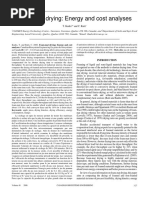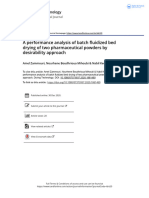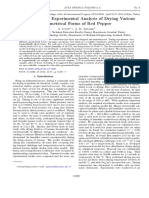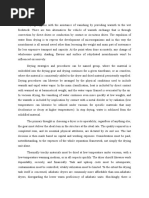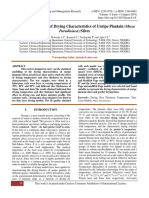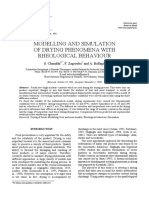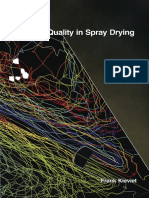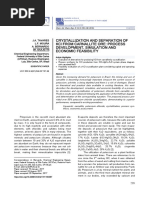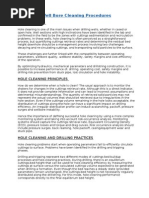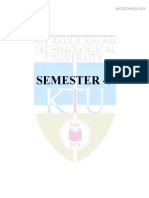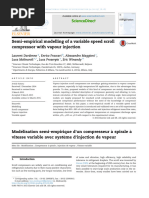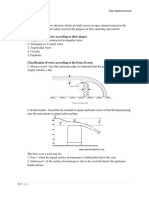Heat and Mass Transfer Study in The Spray Drying of Tomato Juice
Heat and Mass Transfer Study in The Spray Drying of Tomato Juice
Uploaded by
fatemeh afariCopyright:
Available Formats
Heat and Mass Transfer Study in The Spray Drying of Tomato Juice
Heat and Mass Transfer Study in The Spray Drying of Tomato Juice
Uploaded by
fatemeh afariOriginal Title
Copyright
Available Formats
Share this document
Did you find this document useful?
Is this content inappropriate?
Copyright:
Available Formats
Heat and Mass Transfer Study in The Spray Drying of Tomato Juice
Heat and Mass Transfer Study in The Spray Drying of Tomato Juice
Uploaded by
fatemeh afariCopyright:
Available Formats
5th WSEAS Int. Conf.
on Heat and Mass transfer (HMT'08) , Acapulco, Mexico, January 25-27, 2008
Heat and Mass transfer Study in the Spray Drying of Tomato Juice
ANGEL DHARSHINI. S*, VICTOR PAUL. S†, BENSELY. A*, GODSON ASIRVATHAM. L†
†
School of Mechanical Sciences, Karunya Institute of Technology & Sciences,
Karunya Nagar, Coimbatore- 641 114
*
Department of Mechanical Engineering, College of Engineering, Guindy, Anna University
Sardar Patel Road, Chennai- 600025
INDIA
lgodson@rediffmail.com www.karunya.edu
Abstract:
Spray drying is a procedure which is now used for a wide range of applications ranging from food
products to chemicals. In this work, a co-current spray dryer is used and the tomato juice feed is initially
heated to a temperature of 60 ºC. Also, pressurized nitrogen gas is used for atomizing the feed and
thereby improving the performance of the spray dryer. Experiments have been performed at different inlet
air temperatures while the other parameters like air flow rate, feed flow rate and feed temperature are
maintained essentially constant. Through this study, it is found that immediately after the atomized feed
are exposed to the drying medium, the relative humidity of the drying air reaches a maximum (99.99%
RH), remains constant during the spray time and then decreases when the spray time is over. It is also
found that, as the inlet air temperature is varied from 133 ºC to 161 ºC, there is an increase of 11.62% in
heat transfer rate and a marginal increase of 0.51% in mass transfer rate.
Key-Words: Spray drying, Co-current dryer, Tomato juice, Heat transfer, Mass transfer, Feed heating
1 Introduction advantages including ease of packaging,
Spray drying is a procedure which in many transportation and mixing.
industries meets dried product specifications
The co-current dryer, used in the experiment is
most desirable for subsequent processing or
preferred for heat sensitive products because the
direct consumer usage. Intensive research and
inlet drying air contacts the atomized droplets
development during the last two decades has
when their moisture content is at a maximum.
resulted in spray drying becoming a highly
Here, the heat and mass balance for the system
competitive means of drying a wide variety of
is evaluated to find out the quantity of drying air
products. Spray drying has moved into all major
per hour to remove the water content in the
industries ranging from production in the most
juice.
delicate of conditions laid down in food and
pharmaceutical manufacturing right through the
high tonnage outputs for processing of clays, 2 Literature Review
mineral ores and chemicals. In this work, a spray Adamopoulous et al., [1] studied the spray drying
dryer has been developed for fruit juice drying of tomato pulp in dehumidified air and its effect
(tomato). Fruit juices in solid form have many on product recovery. It is found that
dehumidified air which is used as the drying
ISSN: 1790-2769 Page 156 of 243 ISBN: 978-960-6766-31-2
5th WSEAS Int. Conf. on Heat and Mass transfer (HMT'08) , Acapulco, Mexico, January 25-27, 2008
medium can increase product recovery initially. Therefore, an attempt is made to heat
compared to undehumidified air. The product the feed (tomato juice) to 60 ºC.
recovery and residue accumulation which
depends on inlet temperature, drying air flow 3 Theoritical Considerations
rate and compressed air flow rate was found to 3.1 General guidelines for spray dryer
be 36.63%- 65.82% higher and 20.17%- 45.83%
design
higher as compared to spray system using
undehumidified air. Adamopoulous et al.,[2] The basic design selects itself from the given
studied the effect of dehumidified type spray powder specifications such as particle size
drying system on powder properties. On distribution, particle form and the maximum
research it was found that powder moisture temperature to which particles can be subjected
content decreases, solubility increases and bulk to conduct the heat and mass transfer balance
density increases with a decrease in drying air calculations. Sufficient residual time is essential
flow rate. Also, the powder moisture content to permit completion of the drying operation in
decreases and solubility increases with an order to meet the product specification. The
increase in compressed air flow rate. Kieviet et required amount of air flow through the dryer
al.,[3] studied the temperature and humidity may be determined by the heat and mass transfer
pattern in spray drying using a co- current dryer balance calculations but the residual time
and the parameters were measured using a determines the chamber size. As the drying
micro-separator. The pattern was modeled using chamber represents an item of large cost in any
a computational fluid dynamics program and the spray drying installation, correct sizing of the
measured values matched well with the model. drying chamber is essential for minimizing
installation costs.
Fernández-Péreza et al.,[4] investigated the effect
of the inlet air temperature and feed flow rate on Drying chambers are designed to handle an air
the dry product. Results showed that higher the volume containing sufficient heat for drying the
temperature of inlet air, the faster the moisture spray droplets and to provide a residual time
evaporation. However, the powder is subjected sufficient for the droplets to be dried. The
to higher temperatures which may distort the optimum residual time is the time taken for
chemical or physical properties of the product. A completion of drying process with minimum
research made by T. Hino et al [5] investigated increase in the temperature of the drying
the diameters of spray droplets. It was concluded product.
that the finest mists and dried products are
obtained with the use of two fluid phase 3.2 Effect of operating variables on heat
spraying nozzles as they were capable of consumed in dryer
blowing off fine droplets sized 10- 50 µm as
compared to ordinary pressure nozzles which • Inlet temperature: Increase in inlet
produce droplets having a diameter of 102- 103 temperature decreases the amount of heat
µm. Goula A.M et al [6] discussed about the required by the dryer to produce a product
temperature profile of the product during each of given specifications.
spray drying and the product temperature was
found to be constant. And it was observed that in • Feed solid content: Spray drying is an
all experiments, drying was characterized by a expensive method for evaporating volatiles
short equilibrium period, during which the solid and thus to obtain optimum heat utilization
surface conditions are in equilibrium with the conditions, the spray dryer should always
drying air. be fed with the maximum solid feed stock
possible.
From the study made on these literatures, it can
be concluded that the inlet temperature, drying • Drying temperature difference: The higher
air flow rate and feed flow rate play a vital role the temperature difference, the lower the
in spray drying and the feed has not been heated heat required to produce a unit weight of
ISSN: 1790-2769 Page 157 of 243 ISBN: 978-960-6766-31-2
5th WSEAS Int. Conf. on Heat and Mass transfer (HMT'08) , Acapulco, Mexico, January 25-27, 2008
product of constant residual moisture capacity 2.2 kW. The exit temperature of air
content from solid feed stock. This can be from the heater is maintained constant for each
achieved by decreasing outlet temperature experiment. The air flow rate is measured using
or increasing inlet temperature. a pre- calibrated orifice placed upstream from
the heater. A U- tube manometer measures the
• Feed temperature: Increasing the feed pressure drop across the orifice plate. A
temperature reduces the heat required to Chromel- Alumel thermocouple is used to
produce a unit weight of dried product. measure the dry bulb and wet bulb temperatures
Also, pre-heating of feed is normally of the air at inlet. To measure the dry bulb
carried out to reduce the feed viscosity, temperature, wet bulb temperature and relative
thereby improving atomization humidity of air, a thermo- hygrometer
performance and to prevent crystallization (KUSAM- MECO918) is installed at the outlet.
that can cause blockage in the atomizer.
The feed (tomatoes) is crushed to form a puree
after carefully removing the skin and seeds, and
4 Experimental Procedure further refinement is done to reduce the particle
size. And this juice is immediately heated to a
temperature of 60ºC. However, the exact
temperature depends upon the type of tomatoes
used and finished powder specifications. The
feed is then fed into the atomizer through the
pressure vessel which uses inert nitrogen gas at
high temperature. Atomization is done through a
pressure nozzle. The inlet drying air, after
passing through the electrical heater flows co-
currently with the spray where it contacts the
liquid feed droplets and thus evaporation takes
place in the drying chamber. Spray evaporation
is rapid and the temperature of the drying air is
Fig. 1a: Overall setup of spray dryer drastically reduced by the vaporization of water.
Readings are taken by varying the inlet
temperature between 130ºC and 160ºC and
keeping the other parameters such as feed flow
C- COMPRESSOR
AD- AIR DRYER
rate, feed temperature and inlet air flow rate
OM- ORIFICE METER
F- FEED (TOMATO JUICE)
constant. 0.4kg of tomato juice sample was
A.H- AIR HEATER
A.T- AUTO TRANSFORMER taken and heated at a specified temperature of 60
PV- PRESSURE VESSEL
DC- DRYING CHAMBER
A- ATOMISER
ºC and fed into the pressure vessel. Dried
V- VOLTMETER
A- AMMETER
samples are collected from the base of the
T,H- THERMO-
HYGROMETER drying chamber. Some amount of the dried
PR- PRODUCT RECOVERY
sample which is stuck on the circumference of
Fig. 1b: Schematic representation of spray the drier is removed by scraping. The dried
dryer layout sample is weighed and then dried in the oven.
This final sample is again weighed to find out
Fig. 1 shows the schematic arrangement the mass transfer rate in the spray dryer. It is
laboratory scale spray drying system designed determined experimentally that the tomato juice
and constructed to conduct the experimental part specimen contains only 8% solid content as
of the study. Air, supplied by a compressor is compared to the theoretically determined 10%.
passed through an air dryer and a filter to The air flow rate, determined by means of an
remove the moisture and dust present in the air. orifice meter is found to be 0.275 kg/ min.
It is then passed through a heater of maximum
ISSN: 1790-2769 Page 158 of 243 ISBN: 978-960-6766-31-2
5th WSEAS Int. Conf. on Heat and Mass transfer (HMT'08) , Acapulco, Mexico, January 25-27, 2008
The total heat transfer may be calculated as per 120
Ti = 133 ºC
the following relation,
100
QT = CP(TP- TC) + XaCL (TV- TF) + (Xa-Xa)λ + 80
mF
RH (%)
60
XbCL(TP-TV) + (Xa- Xb)CV(TO- TV) (1)
40
where,
CP , Specific heat of ice = 2.1 kJ/kg K 20
CL , Specific heat of water = 4.2 kJ/kg K 0
CV , Specific heat of vapour [9] =2. 205 kJ/kg K
0
20
40
60
80
0
10
12
14
16
18
TP , Tomato Powder Temperature (ºC) Time (s)
TF , Tomato pulp feed Temperature (ºC)
TV , Vapourising Temperature (ºC) Fig. 2: Plot of Exit Relative Humidity w.r.t.
TO , Exit Temperature (ºC) Time (Ti = 133 ºC)
Xa , Initial moisture content (%) 120
Xb , Final moisture content (%)
λ- Latent heat of vapourization (kJ/kg) 100
Ti = 141 ºC
80
The mass transfer rate in the actual spray drying
process is calculated as RH (%) 60
Mass Transfer Rate = ms * (Xa- Xb) (2) 40
20
where,
Xa , Initial moisture content (%) 0
Xb , Final moisture content (%)
0
20
40
60
80
0
10
12
14
16
18
Time (s)
Fig. 3: Exit Relative Humidity of Air vs. Time
5 Results and Discussion (Ti = 141 ºC)
An increase of 30 ºC in air inlet temperature
120
results in an increase of 11.62% in heat transfer Ti = 149 ºC
rate and a marginal increase of 0.51% in mass 100
transfer rate.
RH (%)
80
Ti Heat Transfer Mass Transfer 60
0
( C) Rate Rate
40
(kJ/ min) (kg/ min)
133 652.501 0.3682 20
141 695.478 0.3693
0
149 706.557 0.3695
0
157 712.369 0.3697
20
40
60
80
10
12
14
16
18
Time (s)
162 728.397 0.3701
Table1: Comparison of heat and mass Fig. 4: Plot of Exit Relative Humidity of Air
transfer rates at varying inlet air w.r.t. Time (Ti= 149 ºC)
temperatures
ISSN: 1790-2769 Page 159 of 243 ISBN: 978-960-6766-31-2
5th WSEAS Int. Conf. on Heat and Mass transfer (HMT'08) , Acapulco, Mexico, January 25-27, 2008
120 Fig. 7: Effect of Air Inlet Temperature(Ti) on
Heat Transfer Rate
100 Ti = 157 ºC
Fig 7. shows the plot between heat transfer rate
and air inlet temperature and it can be inferred
RH (%)
80
that heat transfer depends upon the temperature
60 difference of the inlet and outlet drying air
temperature. Also, increasing the drying air inlet
40 temperature leads to increase in heat transfer
rate. For an increase of 30 ºC in air inlet
20 temperature, there is an 11.62% increase in heat
transfer rate.
0
0.3705
0
0
20
40
60
80
0
10
12
14
16
18
Time (s)
Mass transfer rate (kg/ min)
0.37
0.3695
Fig. 5: Plot of Exit Relative Humidity of Air 0.369
w.r.t. Time (Ti = 157 ºC) 0.3685
0.368
120
0.3675
100 0.367
Ti= 162 ºC
133 141 149 157 162
80 Inlet air temperature Ti (K)
RH (%)
60
Fig. 8: Effect of Air Inlet Temperature (Ti) on
40
Mass Transfer Rate
20
As seen from Fig. 8, the increase in drying air
0
inlet temperature leads to increase in the mass
transfer rate in the actual spray drying process.
0
20
40
60
80
0
10
12
14
16
18
Time (s)
But in this case, there is only a marginal increase
Fig. 6: Plot of Exit Relative Humidity of Air in mass transfer rate (0.51%) for an increase of
w.r.t. Time (Ti= 162 ºC) 30 ºC in air inlet temperature.
Ti = 133 ºC
In the above figures (2 to 6), the relative 90
Ti = 141 ºC
Outlet air temperature Tout (ºC)
humidity of air at the exit increases as soon as 85 Ti= 149 ºC
the droplets come into contact with drying air. 80 Ti = 157 ºC
Ti= 162 ºC
Immediately it reaches 100% RH and remains 75
constant during spray time and finally it begins 70
to decrease when the spray time is over.
65
740
60
55
Heat transfer rate (kJ/ min)
720
700 50
680
0
0
20
40
60
80
0
10
12
14
16
18
660 Time (s)
640
620 Fig. 9: Plot of Air Outlet Temperature (Tout
600 K) w.r.t. Time
133 141 149 157 162
Inlet air temperature Ti (K)
ISSN: 1790-2769 Page 160 of 243 ISBN: 978-960-6766-31-2
5th WSEAS Int. Conf. on Heat and Mass transfer (HMT'08) , Acapulco, Mexico, January 25-27, 2008
As is evident from Fig. 9, the air outlet Engineering Science, Vol. 22, 1997, pp.
temperature is higher for higher drying air inlet 39-55
temperature. Also, the outlet air temperature
initially reduces drastically when it contacts the 4. Fernández-Péreza, V., Tapiadorb, J.,
liquid droplets and later becomes constant Martínc, A., Luque de Castro, M. D.,
during the spray time. This plot is similar to that ‘Optimization of the drying step for
obtained by researchers Kieviet et al. [3] preparing a new commercial powdered
soup’, Innovative Food Science and
Emerging Technologies, Vol. 5, 2004,
pp. 361- 368
6 Conclusion
• The quantity of air and heat required is 5. Hino, T., Shimabayashi, S., Ohnishi, N.,
lesser compared with the non feed heating et al, ‘ Development of a New Type
spray drying system. Nozzle and Spray Dryer for Industrial
Production of Fine Powders’, European
• The temperature and humidity profile of the Journal of Pharmaceutics and
actual spray drying process are drawn and Biopharmaceutics, Vol. 49, 2000, pp.
compared. It can be seen that a dryer has 79- 85
almost constant temperature and humidity
during spray time. 6. Goula, A. M., Adamopoulos, K. G.,
‘Spray Drying Performance of a
• The heat and mass transfer rate depends on Laboratory Spray Dryer for Tomato
the rate at which the drying medium Powder Preparation’, Drying
contacts the liquid droplets i.e., the heat and Technology, Vol. 21, 2003, pp. 1273-
mass transfer rate increases with increase in 1289
air inlet temperature and the moisture
content in the final product is reduced when 7. ‘BETE Spray Dry Manual’, BETE Fog
the air inlet temperature increases. Nozzle, Inc, 2005.
• For an increase of 30 ºC in air inlet 8. Masters, K., ‘Spray drying handbook’,
temperature, there is an 11.62% increase in George Godwin Ltd, Londres, 1979
heat transfer rate and a marginal increase of
0.51% in mass transfer rate. 9. Warren L. McCabe, Julian C. Smith,
Peter Harriott, Unit Operations of
Chemical Engineering, Fifth Edition,
References: McGraw- Hill International, 1993
1. Goula, A. M., Adamopoulos, K. G.,
‘Spray Drying of Tomato Pulp in 10. Bannnerot, R. B., Cox, J.E., Chen, C.K.,
Dehumidified Air: I, The effect on Heidelbaugh, N. D., ‘Thermal
Product Recovery’, Journal of Food Preparation of food in space- vehicle
Engineering, Vol. 66, 2005, pp. 25- 34 entertainment’, Aerospace Medicine,
Vol. 45, 1974, pp. 263-265.
2. Goula, A. M., Adamopoulos, K. G.,
‘Spray Drying of Tomato Pulp in 11. Goula, A. M., Adamopoulos, K. G.,
Chatzitakis, P.C., Nikas, V.A.
Dehumidified Air: I, The effect on
‘Prediction of Lycopene Degradation
Powder Properties’, Journal of Food
during a Drying Process of Tomato
Engineering, Vol. 66, 2005, pp. 35- 42
Pulp’, Journal of Food Engineering,
3. Kieviet, F.G., Kerkhof, P.J.A.M., ‘Air Vol. 74, 2006, pp. 37- 46.
flow, temperature and humidity patterns
12. Gransmith M., ‘Dehydration of foods.
in a co-current spray dryer: Modeling
In: Practical dehydration', London, UK:
and Measurements’, Chemical
Food Trade. Press, 1971, pp. 125–33.
ISSN: 1790-2769 Page 161 of 243 ISBN: 978-960-6766-31-2
You might also like
- Asko dw20 Dishwasher SerDocument40 pagesAsko dw20 Dishwasher SerChad HenkeNo ratings yet
- Work Execution Plan For Surface Well TestingDocument12 pagesWork Execution Plan For Surface Well Testinginyene ekere100% (3)
- Use Manual CFDDocument98 pagesUse Manual CFDVu Thanh100% (1)
- Performance Evaluation of Heat Pump Dryer: Khan M. KDocument5 pagesPerformance Evaluation of Heat Pump Dryer: Khan M. KkesdamileNo ratings yet
- Characterization of Drying Behavior and Modeling of Industrial Drying ProcessDocument9 pagesCharacterization of Drying Behavior and Modeling of Industrial Drying ProcessMilos VasicNo ratings yet
- Chen 2016Document51 pagesChen 2016Harold fotsingNo ratings yet
- Thenovelvacuumdryingusingthesteamejector Suryanto Journal Q1Document9 pagesThenovelvacuumdryingusingthesteamejector Suryanto Journal Q1Lê Hải PhongNo ratings yet
- Spray DryerDocument21 pagesSpray Dryersundhar100% (3)
- Integration of A Rotary Desiccant Wheel Into A Hot-Air Drying System: Drying Performance and Product Quality StudiesDocument9 pagesIntegration of A Rotary Desiccant Wheel Into A Hot-Air Drying System: Drying Performance and Product Quality StudiesRamasamikannan RamasamikannanNo ratings yet
- Review On The Design of A Tray Dryer System For Agricultural ProductsDocument10 pagesReview On The Design of A Tray Dryer System For Agricultural ProductsDwinaRahmayaniNo ratings yet
- CPP Drying ProcessDocument3 pagesCPP Drying Processdee99No ratings yet
- Air Source Heat Pump System For Drying ApplicationDocument7 pagesAir Source Heat Pump System For Drying ApplicationRackelyne UrbinoNo ratings yet
- Power InvestigacionDocument8 pagesPower InvestigacionIan PellizzariNo ratings yet
- Foam Mat DryingDocument6 pagesFoam Mat DryingArfi MaulanaNo ratings yet
- Zammouri 2020Document23 pagesZammouri 2020Harold fotsingNo ratings yet
- A Study of Efficient Drying Parameters For Bed Dryers: Christopher Tremblay, Dongmei ZhouDocument8 pagesA Study of Efficient Drying Parameters For Bed Dryers: Christopher Tremblay, Dongmei ZhouavgpaulNo ratings yet
- Theoretical and Experimental Analysis of Drying Various Geometrical Forms of Red PepperDocument5 pagesTheoretical and Experimental Analysis of Drying Various Geometrical Forms of Red PepperAnonymous 4SIk3AdnNo ratings yet
- Drying Technology Trends and ApplicationDocument10 pagesDrying Technology Trends and ApplicationvodounnouNo ratings yet
- ChELab-Experiment-3Document5 pagesChELab-Experiment-3working.johnfranciscabreraNo ratings yet
- Review - Spray DryerDocument4 pagesReview - Spray DryerGusmannNo ratings yet
- Design and Development of Fluidized Bed Dryer For Domestic PurposesDocument5 pagesDesign and Development of Fluidized Bed Dryer For Domestic PurposessagarsrinivasNo ratings yet
- Drying Technology: An International JournalDocument9 pagesDrying Technology: An International JournalImen HammoudaNo ratings yet
- Drying Kinetics and Quality of Potato Chips Undergoing Different Drying TechniquesDocument9 pagesDrying Kinetics and Quality of Potato Chips Undergoing Different Drying TechniquesRODRIGO ZARATE CUELLONo ratings yet
- Non Isothermal Drying of Medicinal PlantsDocument11 pagesNon Isothermal Drying of Medicinal PlantsVerónica Sanabria DomínguezNo ratings yet
- Improved Procedure For Natural Convection Garlic DryingDocument7 pagesImproved Procedure For Natural Convection Garlic DryingHakim SemaiNo ratings yet
- Article1380819262_Hany Et AlDocument13 pagesArticle1380819262_Hany Et AlLee SengsouriyaNo ratings yet
- Cane Syrup EvapourationDocument22 pagesCane Syrup EvapourationAnil Kumar SinghNo ratings yet
- 2020 CombinationofDehumidifierHeatPumpandAirHeaterDocument12 pages2020 CombinationofDehumidifierHeatPumpandAirHeaterMustafa VatanseverNo ratings yet
- Iads 2005Document11 pagesIads 2005Alegría LeeNo ratings yet
- Atmospheric Freeze Drying-A ReviewDocument12 pagesAtmospheric Freeze Drying-A ReviewNguyen Thu HaNo ratings yet
- The Temperature Uniformity During Air Drying of ADocument32 pagesThe Temperature Uniformity During Air Drying of AMUHAMMAD AFIF BIN MOHAMED SALLEH / UPMNo ratings yet
- Journal of Scientific and Engineering Research, 2018, 5 (2) :40-56Document17 pagesJournal of Scientific and Engineering Research, 2018, 5 (2) :40-5611751175No ratings yet
- Experimental Analysis of Fluidized Bed Freeze DryingDocument7 pagesExperimental Analysis of Fluidized Bed Freeze DryingMohamadMostafaviNo ratings yet
- Hal 00895375Document12 pagesHal 00895375muyodi yahayaNo ratings yet
- CFD Studies On Different Configurations of Drying Chamber For Thin-Layer Drying of LeavesDocument14 pagesCFD Studies On Different Configurations of Drying Chamber For Thin-Layer Drying of LeavesSurulivelrajantNo ratings yet
- 10.1515 - Phys 2022 0206Document14 pages10.1515 - Phys 2022 0206Dong Yoo KimNo ratings yet
- KhanDocument4 pagesKhanirfan hilmanNo ratings yet
- JCHEMLETT Volume 2 Issue 4 Pages 178-187Document10 pagesJCHEMLETT Volume 2 Issue 4 Pages 178-187muyodi yahayaNo ratings yet
- Statistical Modelling of Drying Characteristics of Unripe Plantain (Musa Paradisiaca) SlicesDocument10 pagesStatistical Modelling of Drying Characteristics of Unripe Plantain (Musa Paradisiaca) SlicesIJEMR JournalNo ratings yet
- Modelling and Simulation of DryingDocument12 pagesModelling and Simulation of DryingWalterNo ratings yet
- Dehydrator Exhaust Recirculation For Energy Savings Fapc 181Document4 pagesDehydrator Exhaust Recirculation For Energy Savings Fapc 181AbdullahWagimanNo ratings yet
- Study of Drying of PineapleDocument10 pagesStudy of Drying of PineapleSerge KewouNo ratings yet
- Author's Accepted ManuscriptDocument11 pagesAuthor's Accepted Manuscriptchaima rekikNo ratings yet
- Northbrook CollegeDocument10 pagesNorthbrook CollegeDaniyal AsifNo ratings yet
- Fluidized Bed Drying of Corn, Bean and ChickpeaDocument18 pagesFluidized Bed Drying of Corn, Bean and ChickpeaFiraz RizaldyNo ratings yet
- Optimum Design of Evaporative Air Cooler: February 2019Document14 pagesOptimum Design of Evaporative Air Cooler: February 2019najibaNo ratings yet
- Grain Dryer Temperature Optimisation With Simulation and A Test Dryer 3Document6 pagesGrain Dryer Temperature Optimisation With Simulation and A Test Dryer 3ZaharanNo ratings yet
- Article Review (Spray Drying)Document20 pagesArticle Review (Spray Drying)muhammadhaini99No ratings yet
- Designing of A Heat Pump Dryer For Drying of PlumDocument4 pagesDesigning of A Heat Pump Dryer For Drying of PlumAdetunji AdebayoNo ratings yet
- Syahrul 2002Document19 pagesSyahrul 2002Harold fotsingNo ratings yet
- AbhiiiiDocument21 pagesAbhiiiisreenuNo ratings yet
- Analisis Las Transferencias de Calor y Masa Durante El Secado de Alimentos Por MicroondasDocument11 pagesAnalisis Las Transferencias de Calor y Masa Durante El Secado de Alimentos Por MicroondasAngeliika AviilaNo ratings yet
- Unit Operation Laboratory 2 (CCB 3062)Document7 pagesUnit Operation Laboratory 2 (CCB 3062)Carl Erickson100% (1)
- 1997-Modelling Quality in Spray DryingDocument117 pages1997-Modelling Quality in Spray DryingAndres Palacio AlvarezNo ratings yet
- Influence of Environmental Conditions On Drying Efficiency and Heat Pump Performance in Closed and Open Loop Drying of PaddyDocument15 pagesInfluence of Environmental Conditions On Drying Efficiency and Heat Pump Performance in Closed and Open Loop Drying of PaddyRackelyne UrbinoNo ratings yet
- Three-Dimensional CFD Simulation Ofa "Steam Water Spray" Retort Process For Food Vegetable ProductsDocument15 pagesThree-Dimensional CFD Simulation Ofa "Steam Water Spray" Retort Process For Food Vegetable ProductsWilliam Rolando Miranda ZamoraNo ratings yet
- My Paper in Willey JournalDocument14 pagesMy Paper in Willey JournalPradyumna DhamangaonkarNo ratings yet
- Dryer Handbook PDFDocument60 pagesDryer Handbook PDFselviraNo ratings yet
- Energy Sources Volume 18 Issue 4 1996 (Doi 10.1080 - 00908319608908781) KHATTAB, N. M. - Toward A Homogeneous and Efficient Batch-Tray Dryer PDFDocument14 pagesEnergy Sources Volume 18 Issue 4 1996 (Doi 10.1080 - 00908319608908781) KHATTAB, N. M. - Toward A Homogeneous and Efficient Batch-Tray Dryer PDFNIKHIL SHINDENo ratings yet
- Fluidized Bed Drying of A Pharmaceutical Powder: A Parametric Investigation of Drying of Dibasic Calcium PhosphateDocument19 pagesFluidized Bed Drying of A Pharmaceutical Powder: A Parametric Investigation of Drying of Dibasic Calcium PhosphateadcomsintlNo ratings yet
- Temperature and Humidity Independent Control (THIC) of Air-conditioning SystemFrom EverandTemperature and Humidity Independent Control (THIC) of Air-conditioning SystemNo ratings yet
- Advances in Air Conditioning Technologies: Improving Energy EfficiencyFrom EverandAdvances in Air Conditioning Technologies: Improving Energy EfficiencyNo ratings yet
- Crystallization and Separation of KCL From Carnallite Ore: Process Development, Simulation and Economic FeasibilityDocument11 pagesCrystallization and Separation of KCL From Carnallite Ore: Process Development, Simulation and Economic Feasibilityfatemeh afariNo ratings yet
- Patent 03Document6 pagesPatent 03fatemeh afariNo ratings yet
- Patent 01Document3 pagesPatent 01fatemeh afariNo ratings yet
- Ammonium Chloride-Reaction EquilibriumDocument6 pagesAmmonium Chloride-Reaction Equilibriumfatemeh afariNo ratings yet
- Pharmaceutical Spray DryingDocument16 pagesPharmaceutical Spray DryingLBNo ratings yet
- 1spray Dryer - 1Document10 pages1spray Dryer - 1fatemeh afariNo ratings yet
- Process Report For Saturator Blow Down Drum D-6002: Marjan Petrochemical CompanyDocument9 pagesProcess Report For Saturator Blow Down Drum D-6002: Marjan Petrochemical Companyfatemeh afariNo ratings yet
- Ebook Computational OptimizationDocument237 pagesEbook Computational Optimizationfatemeh afariNo ratings yet
- Canter Euro Vi - 02 - 202301 - 07Document774 pagesCanter Euro Vi - 02 - 202301 - 07cesar lozanoNo ratings yet
- Oxygen Gas Transmission Rate Through Plastic Film and Sheeting Using A Dynamic Accumulation MethodDocument7 pagesOxygen Gas Transmission Rate Through Plastic Film and Sheeting Using A Dynamic Accumulation MethodMartin TapankovNo ratings yet
- Oil Pumping and Metering Part of The Petroleum ProceDocument77 pagesOil Pumping and Metering Part of The Petroleum ProcefructoraNo ratings yet
- Fmh02 Tech 02Document9 pagesFmh02 Tech 02sureshNo ratings yet
- Tutorial PackedBedDocument2 pagesTutorial PackedBedtejkiranNo ratings yet
- Hole Cleaning ProblemDocument4 pagesHole Cleaning ProblemSamad Ali Siddiqui100% (1)
- Sk-500Iii/Iiia/Iiib/Iiic: Multi-Channel Syringe PumpDocument2 pagesSk-500Iii/Iiia/Iiib/Iiic: Multi-Channel Syringe PumpSico LabenNo ratings yet
- Fundamentals of Leak Testing: Test CategoryDocument3 pagesFundamentals of Leak Testing: Test CategoryssdxyjNo ratings yet
- 1 s2.0 S2214785320397339 MainDocument7 pages1 s2.0 S2214785320397339 Maindanish khanNo ratings yet
- VentillationDocument13 pagesVentillationhurry yashwantNo ratings yet
- Hygienic DesignDocument18 pagesHygienic DesignJosé Luis García PérezNo ratings yet
- The Compact LightweightDocument24 pagesThe Compact LightweightJose SilvaNo ratings yet
- 8800A Production Training-2020Document25 pages8800A Production Training-2020africasemiconductorNo ratings yet
- NASA Document On Jet NozzlesDocument11 pagesNASA Document On Jet NozzlesBahadorNo ratings yet
- Cat Mining Construction 2016Document24 pagesCat Mining Construction 2016AlejandroNo ratings yet
- Unloading Relief Valves: Pressure ControlsDocument6 pagesUnloading Relief Valves: Pressure ControlsmdkhandaveNo ratings yet
- Biotechnology Engineering 2019 SyllabusDocument139 pagesBiotechnology Engineering 2019 SyllabusprarthanaNo ratings yet
- PT868 User's ManualDocument246 pagesPT868 User's ManualshankymaniramNo ratings yet
- Dardenne 2015Document12 pagesDardenne 2015Limas ramirez José AntonioNo ratings yet
- National Oil Corporation: Rev Date Description Checked ApprovedDocument37 pagesNational Oil Corporation: Rev Date Description Checked ApprovedYousab JacobNo ratings yet
- MODULE 5 - WeirDocument11 pagesMODULE 5 - WeirGrace MagbooNo ratings yet
- James Lip Pressure Method in Muara Laboh Robi Irsamukhti WGC 2015Document10 pagesJames Lip Pressure Method in Muara Laboh Robi Irsamukhti WGC 2015Benedict Amandus HanantoNo ratings yet
- MX Series Oval Gear Flowmeter: Instruction ManualDocument32 pagesMX Series Oval Gear Flowmeter: Instruction ManualRómulo Zevallos GutiérrezNo ratings yet
- Krohne Ifc050 ManualDocument84 pagesKrohne Ifc050 ManualDanilo Abrao100% (1)
- GATE CHEMICAL 2018 Solution PDFDocument28 pagesGATE CHEMICAL 2018 Solution PDFAneeta RaniNo ratings yet
- In-Line Detonation Flame Arrester: For Stable Detonations and Defl Agrations in A Straight Through Design, BidirectionalDocument4 pagesIn-Line Detonation Flame Arrester: For Stable Detonations and Defl Agrations in A Straight Through Design, BidirectionalkaramullahrasheedNo ratings yet
- Manual Analizadores URAS CALDOS PDFDocument112 pagesManual Analizadores URAS CALDOS PDFInstrumentacion CotinavecNo ratings yet













